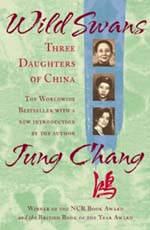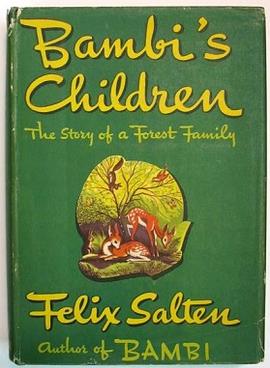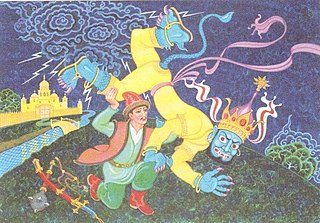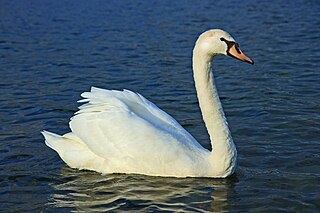
Branwen, Daughter of Llŷr is a major character in the Second Branch of the Mabinogi, which is sometimes called the "Mabinogi of Branwen" after her.

Aloysius Snuffleupagus, more commonly known as Mr. Snuffleupagus or Snuffy for short, is one of the characters on Sesame Street, a PBS/HBO educational television program for young children. His head bears resemblances to giant anteaters and mammoths, but he has no tusks or (visible) ears. He also has a tail similar in shape to that of a dinosaur. He has thick, brown hair and a trunk, or "snuffle", that drags along the ground. Snuffy is also Big Bird's best friend, and has a younger sister named Alice.

Wild Swans: Three Daughters of China is a family history that spans a century, recounting the lives of three female generations in China, by Chinese writer Jung Chang. First published in 1991, Wild Swans contains the biographies of her grandmother and her mother, then finally her own autobiography. Her grandmother had bound feet and was married off at a young age as the concubine of a high-status warlord. Chang's mother rose in status as a member of the Chinese Communist Party. Chang took part in the Cultural Revolution as a member of the Red Guards, but eventually her father was tortured and she was sent to the countryside for thought reform. Later, she earned a scholarship to study in England, where she still lives.

"The Three Ravens" is an English folk ballad, printed in the songbook Melismata compiled by Thomas Ravenscroft and published in 1611, but the song is possibly older than that. Newer versions were recorded up through the 19th century. Francis James Child recorded several versions in his Child Ballads.

The Spiderwick Chronicles is a series of children's fantasy books by Tony DiTerlizzi and Holly Black. They chronicle the adventures of the Grace children, twins Simon and Jared and their older sister Mallory, after they move into the Spiderwick Estate and discover a world of fairies that they never knew existed. The first book, The Field Guide, was published in 2003 and then followed by The Seeing Stone (2003), Lucinda's Secret (2003), The Ironwood Tree (2004), and The Wrath of Mulgarath (2004). Several companion books have been published including Arthur Spiderwick's Field Guide to the Fantastical World Around You (2005), Notebook for Fantastical Observations (2005), and Care and Feeding of Sprites (2006). A second series, entitled Beyond the Spiderwick Chronicles, includes The Nixie's Song (2007), A Giant Problem (2008), and The Wyrm King (2009).

The "swan maiden" story is a name in folkloristics used to refer to three kinds of stories: those where one of the characters is a bird-maiden, in which she can appear either as a bird or as a woman; those in which one of the elements of the narrative is the theft of the feather-robe belonging to a bird-maiden, though it is not the most important theme in the story; and finally the most commonly referred to motif, and also the most archaic in origin: those stories in which the main theme, among several mixed motifs, is that of a man who finds the bird-maiden bathing and steals her feathered robe, which leads to him becoming married to the bird-maiden. Later, the maiden recovers the robe and flies away, returning to the sky, and the man may seek her again. It is one of the most widely distributed motifs in the world, most probably being many millennia old, and the best known supernatural wife figure in narratives.

Chojin Sentai Jetman is a Japanese tokusatsu television series produced by Toei Company. It is the fifteenth entry of the Super Sentai metaseries, following the previous series Chikyu Sentai Fiveman. The series aired on TV Asahi on February 15, 1991, to February 14, 1992, with a total of 51 episodes replacing Chikyu Sentai Fiveman and was replaced by Kyōryū Sentai Zyuranger. The international English title is listed by Toei as simply Jetman.
"The Three Little Birds" is a German fairy tale collected by the Brothers Grimm, tale number 96. The story is originally written in Low German. It is Aarne-Thompson type 707, the dancing water, the singing apple, and the speaking bird. The story resembles Ancilotto, King of Provino, by Giovanni Francesco Straparola, and The Sisters Envious of Their Cadette, the story of the 756th night of the Arabian Nights.

The King of England and his Three Sons is a Romani fairy tale collected by Joseph Jacobs in More English Fairy Tales. He listed as his source Francis Hindes Groome's In Gypsy Tents, where the informant was John Roberts, a Welsh Roma. Groome published the tale as An Old King and his three Sons in England.

Bambi's Children: The Story of a Forest Family is a 1939 coming-of-age novel written by Austrian author Felix Salten as a sequel to his 1923 work Bambi, a Life in the Woods.

The black swan is widely referenced in Australian culture, although the character of that importance historically diverges between the prosaic in the east and the symbolic in the west. The black swan is also of spiritual significance in the traditional histories of many Aboriginal Australian peoples across southern Australia. Metaphoric references to black swans have appeared in European culture since long before Europeans became aware of Cygnus atratus in Australia in the 18th century.

Ural-batyr or Oral-batır is the most famous kubair of the Bashkirs. It is a telling of heroic deeds and legendary creatures, the formation of natural phenomena, and so on.

The Forgotten Beasts of Eld is a fantasy novel by American writer Patricia A. McKillip, and illustrators Peter Schaumann in 1974, and Alicia Austin in 1981, first published by Atheneum Publishers in 1974, and by Magic Carpet Books in 1996. It is the winner of the 1975 World Fantasy Award. The book centers on Sybel, a woman previously cut off from the rest of the world of Eldwold, as she learns to live and love in the world outside of the one she once knew.

The mute swan is a species of swan and a member of the waterfowl family Anatidae. It is native to much of Eurasia, and the far north of Africa. It is an introduced species in North America, home to the largest populations outside of its native range, with additional smaller introductions in Australasia and southern Africa. The name "mute" derives from it being less vocal than other swan species. Measuring 125 to 160 cm in length, this large swan is wholly white in plumage with an orange beak bordered with black. It is recognisable by its pronounced knob atop the beak, which is larger in males.
Loka Táttur or Lokka Táttur is a Faroese ballad which is an example of the occurrence of Norse gods in folklore.
"Save Henry" is the ninth episode of the third season of the American fantasy drama series Once Upon a Time, and the show's 53rd episode overall.

The Sea Tsar and Vasilisa the Wise is a Russian fairy tale published by author Alexander Afanasyev in his collection of Russian Fairy Tales, numbered 219. The tale features legendary characters Sea Tsar and Vasilisa the Wise.
The Goose Wife is a mythical female character that appears in tales from the Inuit and other ethnic groups that dwell across the circumpolar Arctic region. The usual story is that the geese alight on land, become women by taking off their goose-skins and bathe in a lake. However, they are unaware that a human hunter is spying on them, and he steals the goose-skin of one of them, forcing her to be his wife. Due to the great similarities between both characters, the goose wife has been compared to the swan maiden, another female that alternates between human and bird forms.
"The Swan Queen" is a Lithuanian fairy tale related to the character of the swan maiden. In the tale, a peasant couple find a swan or goose and bring it home, which transforms into a human girl they adopt as their daughter. After her birdskin is destroyed and she marries a human prince, her bird flock gives her a new set of garments and she turns back into a bird.
The Beautiful Palace East of the Sun and North of the Earth is a Swedish folktale collected from Smaland by Swedish folktale collectors George Stephens and Gunnar Olof Hyltén-Cavallius. It features versions of the swan maiden, a mythic female character that alternates between human and animal shapes.














